Equal Pay for Equal Work
(From Home)
Remote work's role in the gender pay gap
Introduction
This year, Equal Pay Day falls on April 2nd, 2019. A symbolic day dedicated to raising awareness and improving the gender pay gap between men and women around the world, the day is acknowledged annually by calculating how far into the new year women have to work in order to earn the same amount of money men earned in the previous year.
In the United States, women earn roughly $0.80 for every dollar men make. This inequality compounds to create greater inequality for women over the course of their entire careers. Last year, Equal Pay Day was acknowledged on April 10th, 2018, so the gender pay gap has narrowed -- but only slightly.
We wanted to find out more about the state of equal pay between genders when it comes to remote workers in the United States. We surveyed 2,018 people who are employed full-time and asked them questions about their industry, salary, career growth, and how often they work remotely. We wanted to find disparities in pay, opportunities, and self-perception between people who sometimes, always, and never worked remotely to learn if remote work was creating more opportunities for pay equity, or if the adoption of remote work we've researched was making it even harder for people to achieve fair and equal pay. Keep reading to learn and share our findings about the state of equal pay in the United States -- and how remote work can impact the gender pay gap.
Key Findings
Our data show that there is still a strong gender pay gap between men and women in the United States, regardless of whether they work remotely full-time, sometimes, or not at all. For example, we found that men who work remotely full-time are 25% more likely to earn over $100,000 than women who work remotely full-time.
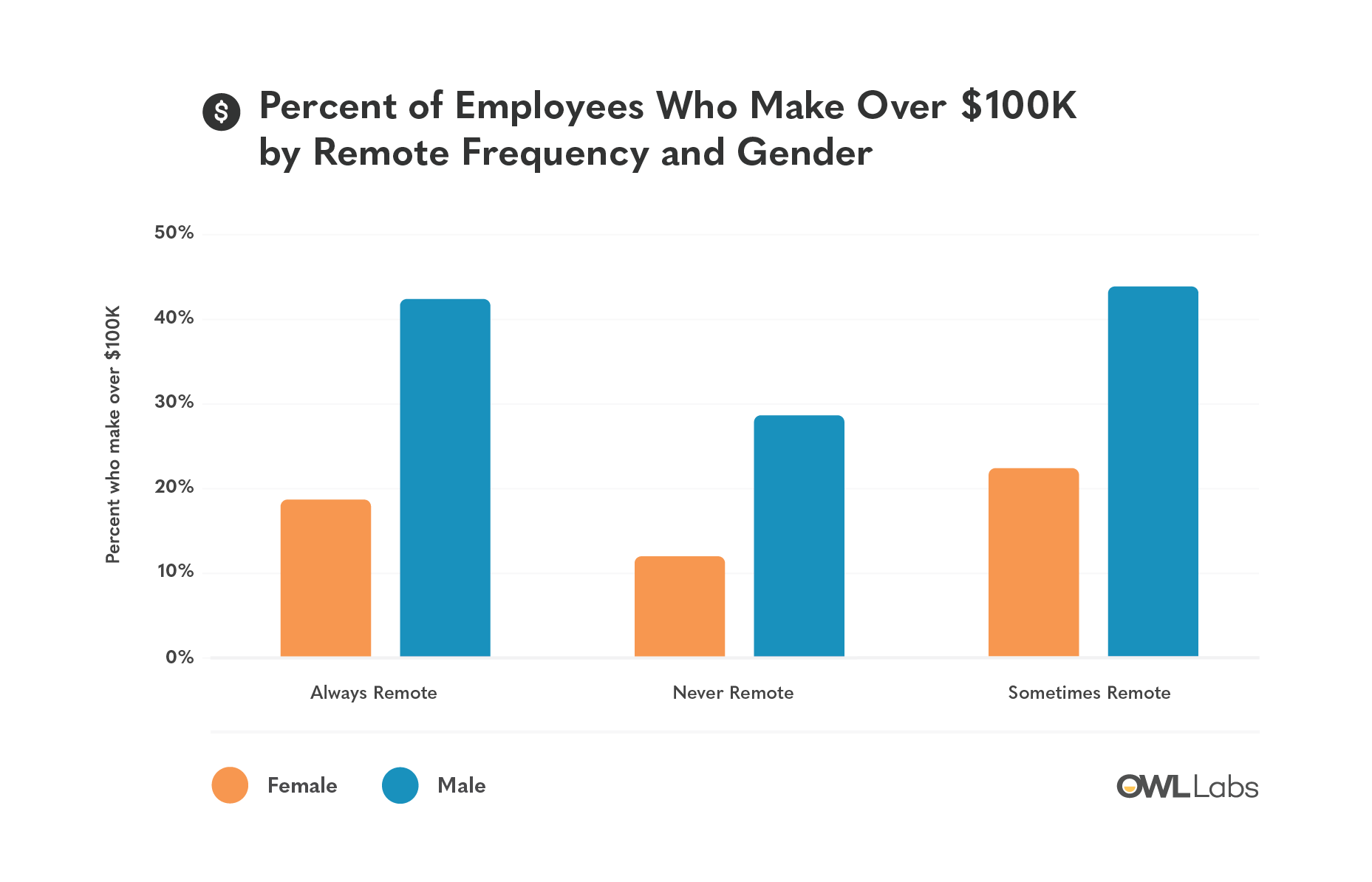
Working Remotely Doesn't Hurt Earning Potential, But the Gender Pay Gap Persists
Looking only at remote work frequency across all genders, working remotely doesn't appear to impact one's earning potential: Respondents who work remotely full-time or sometimes are more likely to earn salaries over $100,000 than respondents who never work remotely.
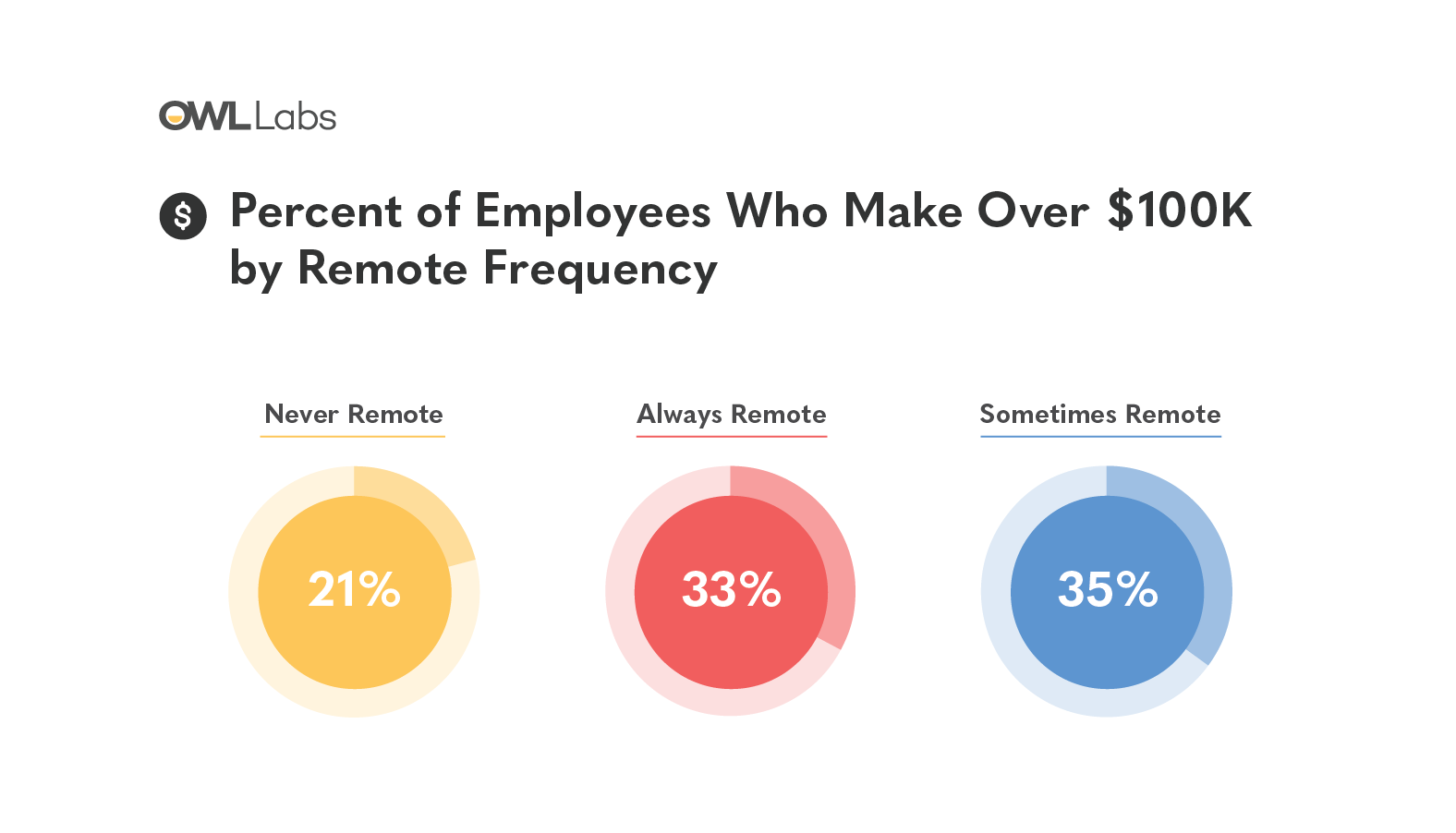
In fact, respondents who always work remotely are 53% to earn salaries of $100,000 or greater than those who never work remotely. Similarly, those who sometimes work remotely are 63% more likely to earn salaries of $100,000 or greater than those who never work remotely. We wonder if this could be the result of remote work being offered as a privilege or reward for high-performers.
However, the gender pay gap persists between male and female remote workers even at these higher salary levels.
Male Remote Workers Earn Higher Salaries than Female Remote Workers
While remote workers are generally more likely to earn higher salaries than respondents who work co-located in an office, this trend is especially pronounced for men: The opportunity for higher salaries increase most significantly for men when they start working remotely, either sometimes or full-time.
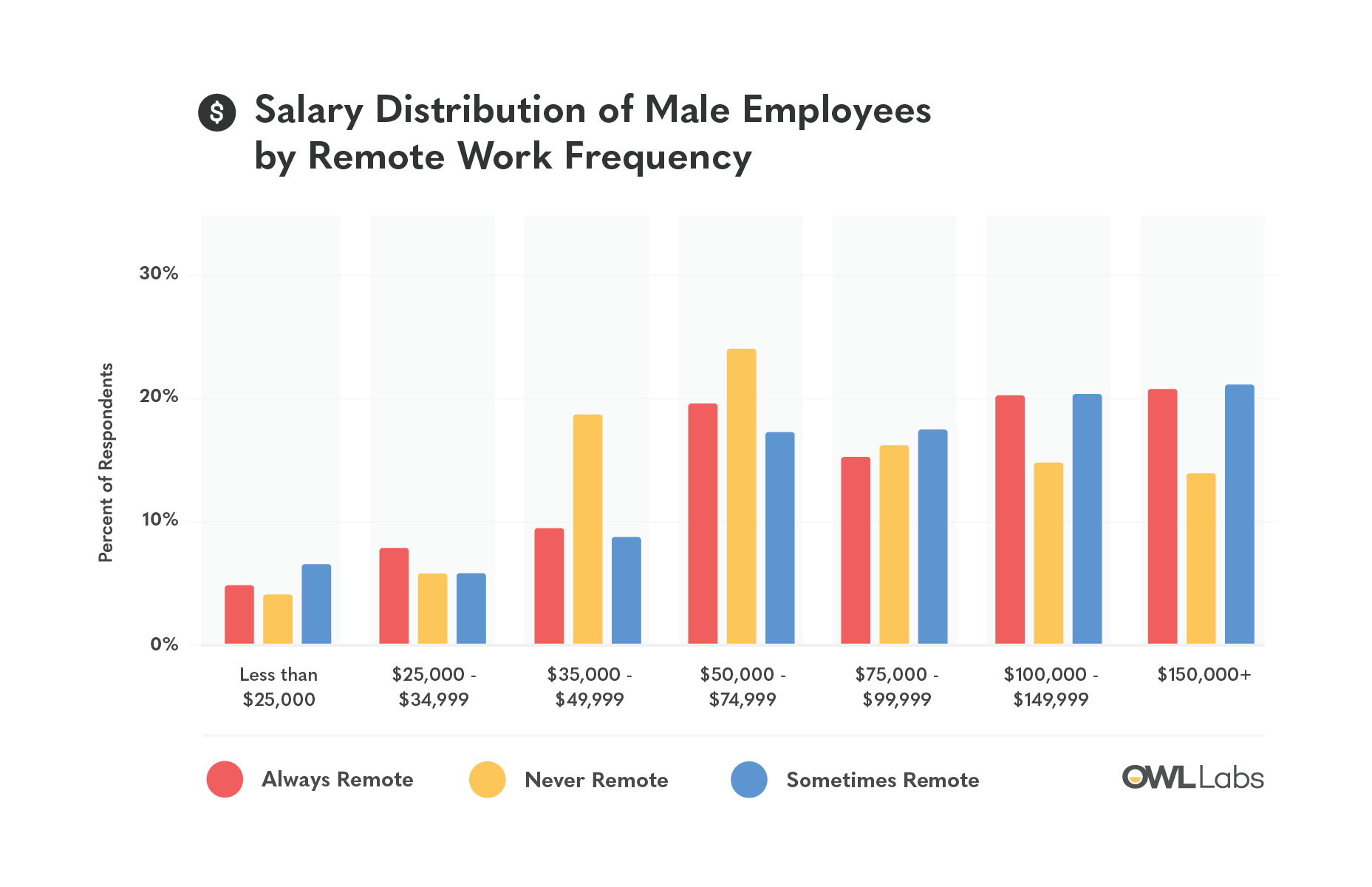
Conversely, women's salaries follow a bell curve distribution of fewer people earning higher salaries, regardless of their working style.
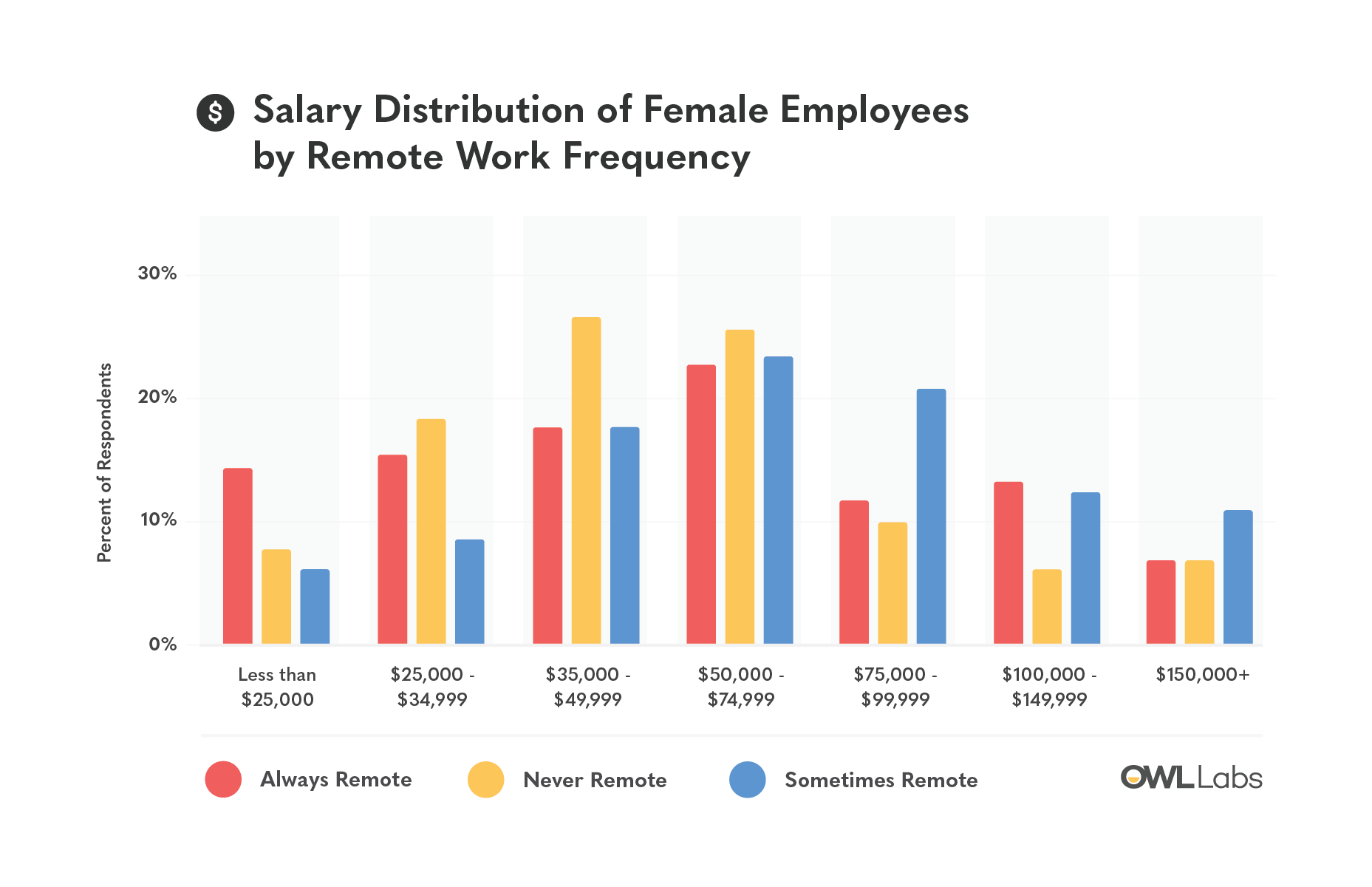
Remote Work Increases Earnings for Men and Women, But the Gender Pay Gap Persists
Among high earners, men and women are more likely to earn higher salaries if they work remotely: Men who always work remotely are 48% more likely to earn $100,000 or more than men who never work remotely, and women who always work remotely are 53% more likely to earn $100,000 or more than women who never work remotely.
While it's encouraging that remote work opens up higher-earning opportunities for women, the most significant pay gap between men and women is between full-time remote workers: Men who work remotely full-time are 25% more likely to earn $100,000 or more than women who work remotely full-time.

Male Individual Contributors Earn More Working Remotely, But The Same Isn't the Case for Female Individual Contributors
We split respondents according to their current roles so we could dig into salary differences among individual contributors and managers. Amongst individual contributors, male individual contributors who work remotely full-time are the highest earners: They're 124% and 58% more likely to earn $100,000 or more than male individual contributors who never or sometimes work remotely, respectively.
The same phenomenon does not occur with female individual contributors, however. In this role, women who sometimes work remotely are the most likely to earn more than $100,000, perhaps indicating that face time in the office is needed for female individual contributors seeking higher earnings. Although remote work flexibility may be used to recruit and retain high-performing male individual contributors, it's a lost opportunity for businesses not to recruit and retain high-performing female individual contributors, too.
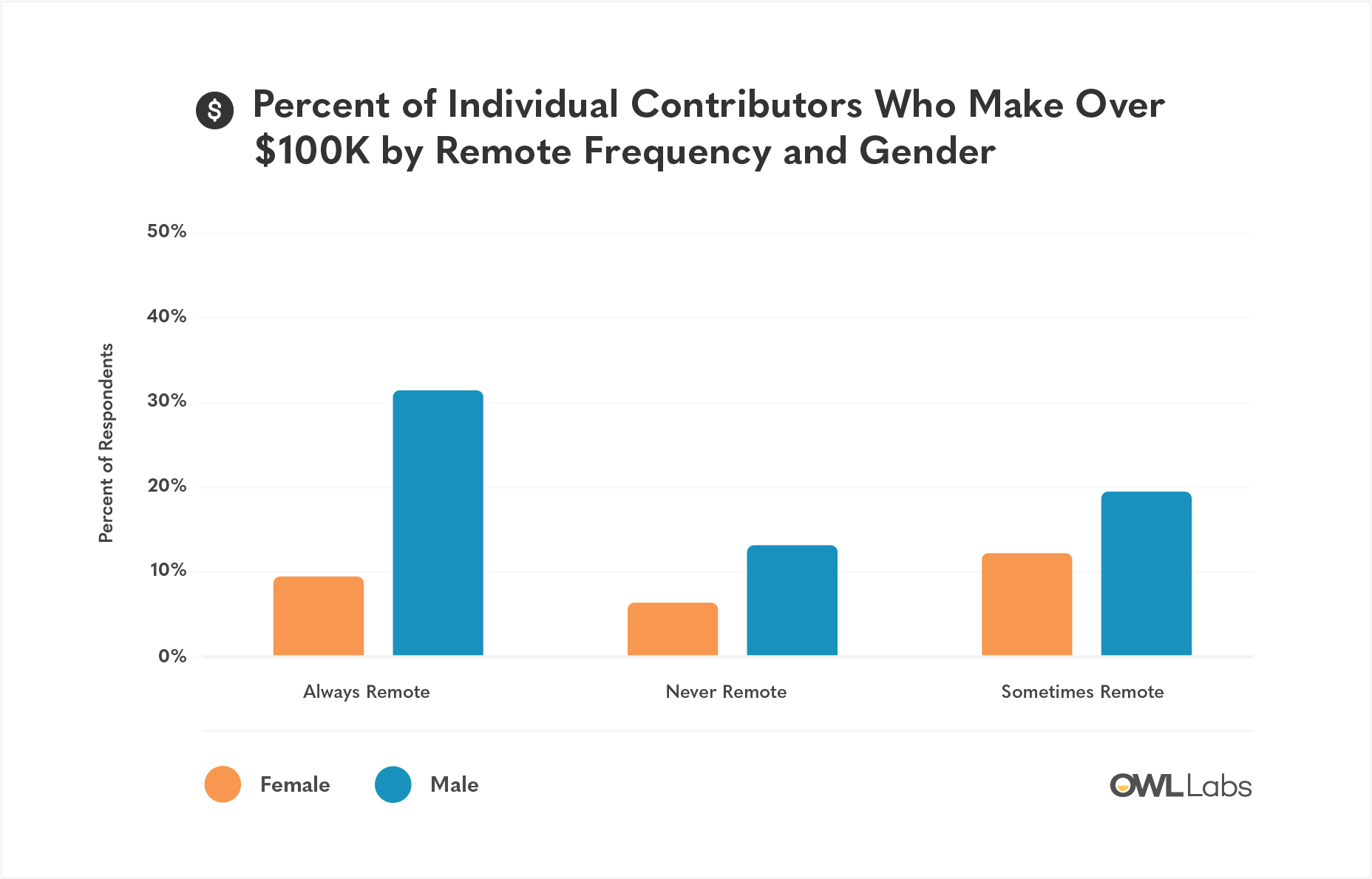
Female Managers Earn Higher Salaries If They Work in an Office
At the manager level, face time in the office appears to have an even greater impact on earning potential. Women who work remotely full-time are 16% less likely to earn $100,000 or more than female managers who never work remotely.
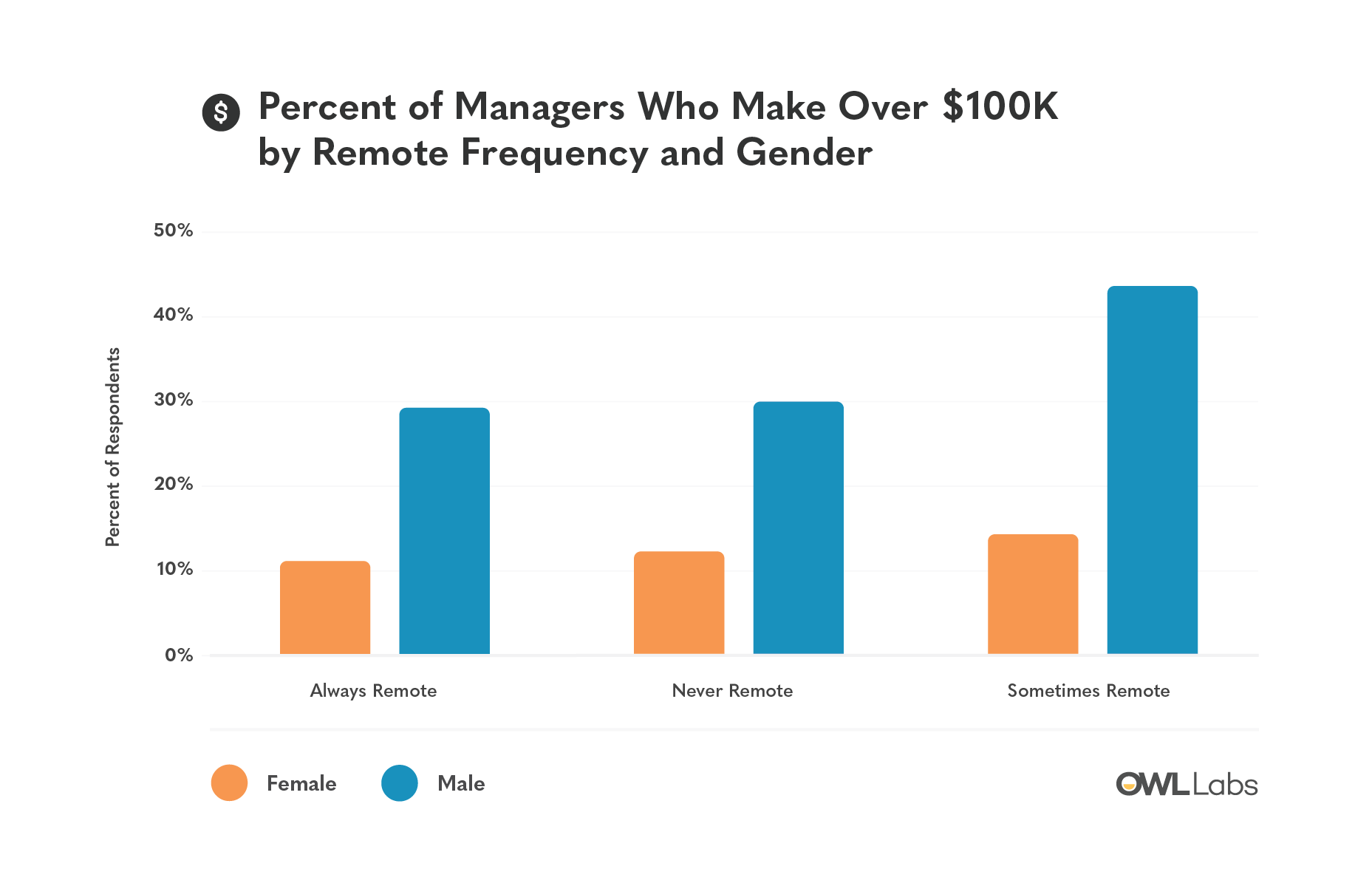
Another example of this phenomenon is evident when comparing men and women: Male managers who sometimes work remotely are 50% more likely to earn over $100,000 compared to their male counterparts who never work remotely. In contrast, female managers who sometimes work remotely are only 33% more likely to earn over $100,000 compared to their female counterparts who never work remotely.
This data indicates that male managers consistently earn higher salaries than female managers, regardless of their working style, and that face time in the office helps female managers climb the ladder and earn higher salaries. The data also indicates that both male and female managers who sometimes work remotely earn the highest salaries of those we surveyed -- perhaps again indicating that the ability to work remotely is a privilege awarded to the highest performers.
Women Who Work Remotely Are Less Optimistic About Their Career Growth
We asked respondents about their perceived opportunities for promotion within the next five years. Women are slightly more optimistic than men in their expectations for receiving at least one promotion in the next five years, but only if they get face time in the office.
Women are least likely to be optimistic about earning a promotion if they work remotely full-time. Conversely, women who never work remotely are 26% more likely to be optimistic about earning a promotion than women who always work remotely. Women who sometimes work remotely are 59% more optimistic about their promotion opportunities than women who work remotely full-time.
Men who always work remotely are significantly more optimistic about their promotion opportunities than women who always work remotely. The data suggest that face time is necessary for women to earn equal pay and climb the ladder in their careers, as women who work remotely full-time are 26% less optimistic about earning a promotion than women who work in an office full-time.
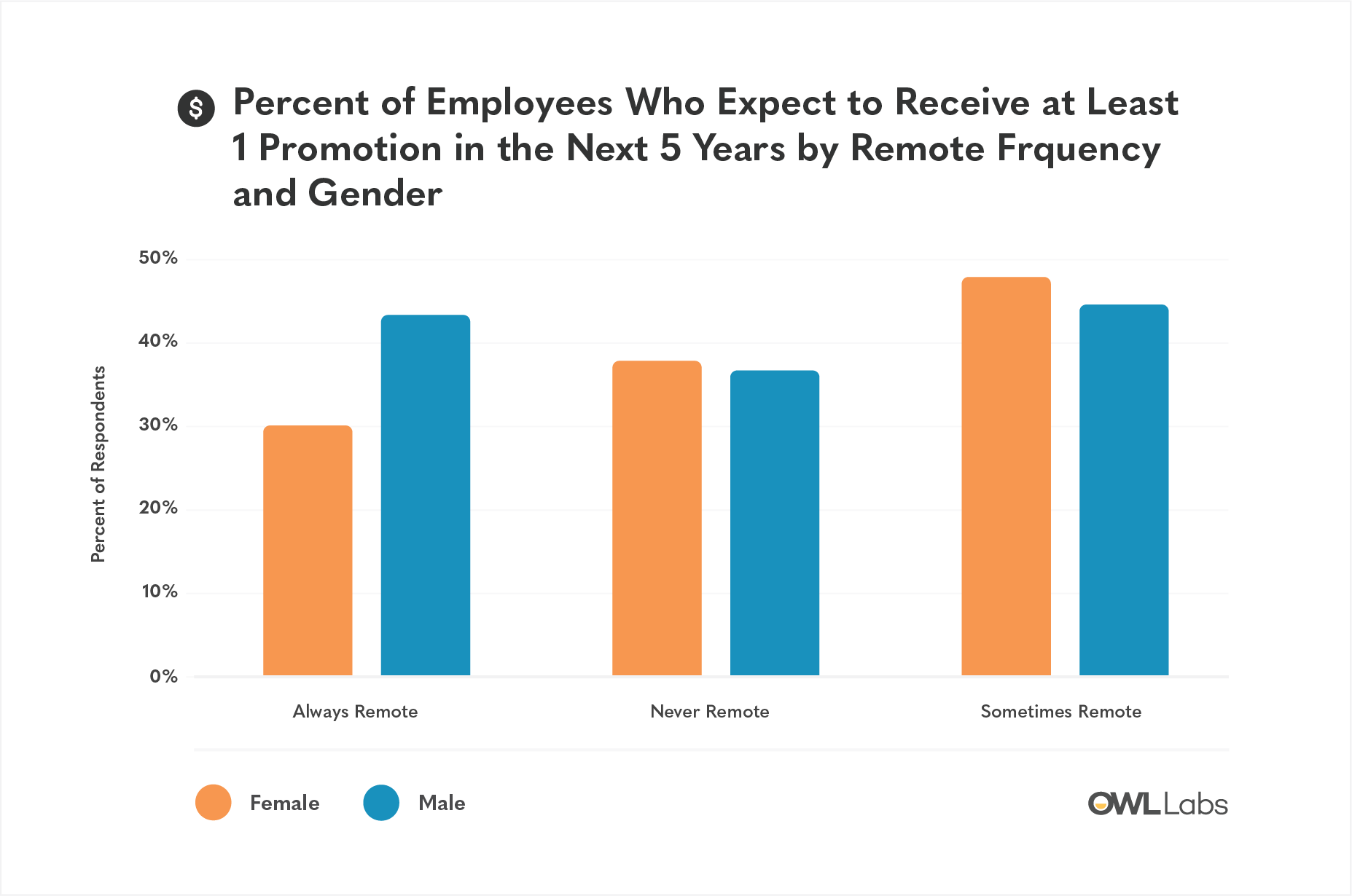
Men Who Work Remotely Are Most Confident in Their Ability to Advance
Among respondents who expect two or more promotions within the next five years, women who never work remotely are more likely to expect a promotion than men who never work remotely. On the other hand, men who work remotely full-time are 45% more likely to expect two or more promotions than women who work remotely full-time.
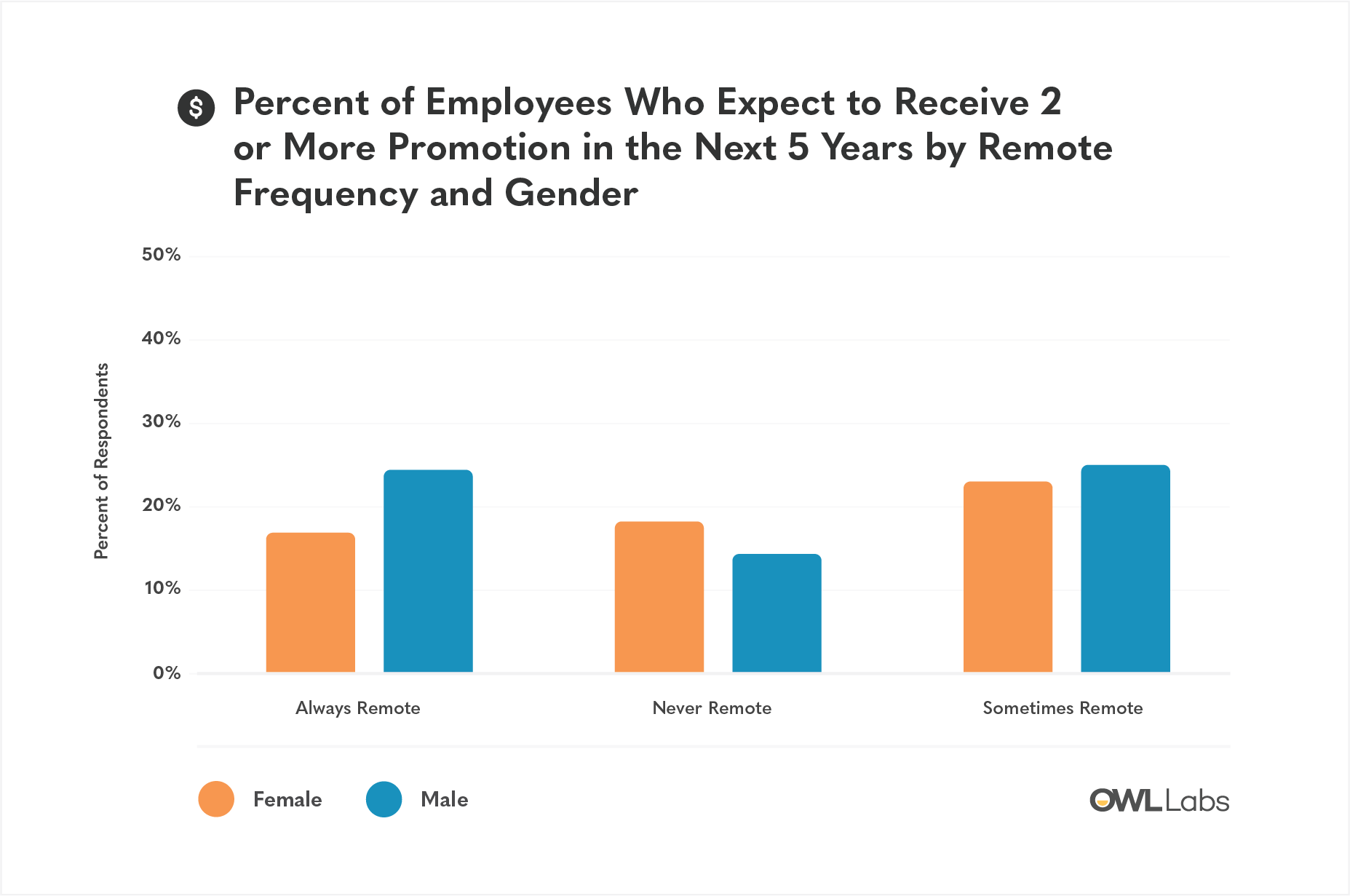
Women Work Remotely to Achieve Greater Work-Life Balance
Finally, we asked respondents about their reasons for working remotely, where we found another divergence between men and women. Women's primary reason for working remotely is to achieve greater work-life balance, which more than 40% of female respondents cited. Men's reasons for working remotely are split between achieving work-life balance (30%) and to increase productivity and focus (28%).
This difference in remote work preference could, unfortunately, be amplifying any workplace biases driving lower pay for remote working women. For example, some businesses assume that mothers who choose to work from home or take time off more frequently are de-prioritizing their work in favor of their family -- it's known as the "motherhood penalty." While we know this is rarely, if ever, the case, women who do choose to work from home for work-life balance reasons could be unknowingly confirming this bias. If true, this unfortunate cycle can only be broken by acknowledging and reducing these biases at every stage of women's careers.
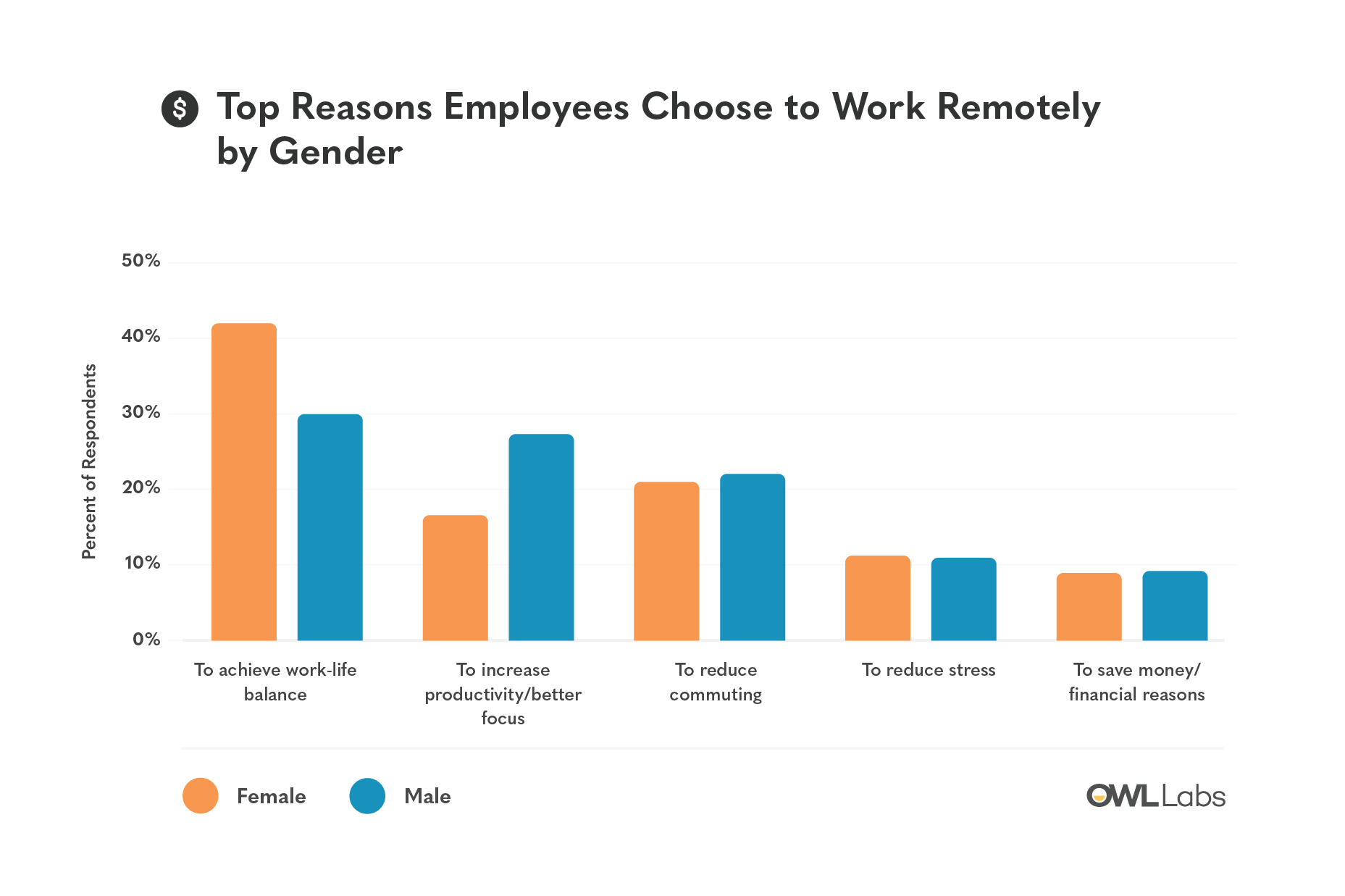
Methodology & Demographics
For this survey, we polled 2,018 full-time workers in the United States using Google Surveys. The data was collected between March 4th-March 11th, 2019, and respondents were between the ages 18-65+. Of our respondents, 52.9% identified as male, 39.4% identified as female, and 7.6% preferred not to say.
Our survey asked questions about the frequency at which individuals worked remotely, and the breakdown of respondents was: 15.8% always work remotely, 32.6% never work remotely, and 51.6% sometimes work remotely.
Conclusion
We at Owl Labs believe that, on Equal Pay Day and every day, hardworking employees should earn a salary that reflects their experience and contributions to the growth of the company they work for. Gender shouldn't play a role in compensation, but as this data shows, unfortunately, gender inequality persists among office workers, remote workers, and everyone in between. Sunlight is the best disinfectant, and greater transparency around persisting gender pay inequality is the only way to achieve better outcomes for all employees, no matter where or how they work.
Join the conversation around Equal Pay Day 2019 using the hashtag #EqualPayDay on social media.
